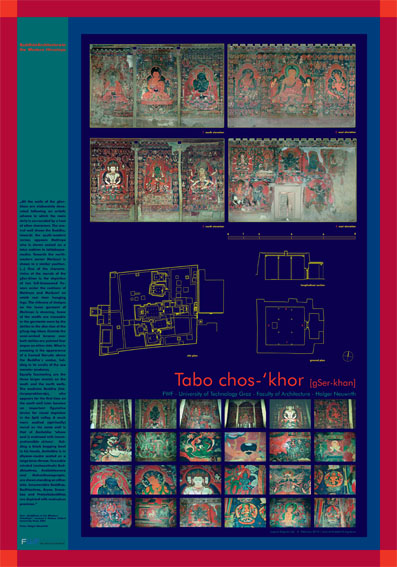
„All the walls of the gSer-khan are elaborately decorated following an artistic scheme in which the main deity is surrounded by a host of other characters. The central wall shows the Buddha, towards the south-western corner, appears Maitreya who is shown seated an a lotus cushion in lalitaksepa-mudra. Towards the north-western corner Mañjusri is shown in a similar position. [...] One of the characteristics of the murals of the gSer-khan is the depiction of two full-blossomed flowers under the cushions of Maitreya and Mañjusri on which rest their hanging legs. The richness of designs on the lower garment of Maitreya is stunning. Some of the motifs are traceable to the garments worn by the deities in the skor-lam of the gTsug-lag-khan. Outside the semi-arched toranas over both deities are painted four stupas on either side. What is amazing is the appearance of a horned Garuda above the Buddha´s usnisa, holding in its scrolls of the sea monster (makara).
Equally fascinating are the three larger murals on the south and the north walls. The medicine Buddha (Vaiduryaprabharaja), who appears for the first time on the south wall later became an important figurative device for visual depiction in the Spiti valley. A much more exalted (spiritually) mural on the same wall is that of Amitabha ‘whose soul is endowed with incomprehensible virtues‘. Holding a black begging bowl in his hands, Amitabha is in dhyana-mudra seated on a large lotus-throne. Two noble minded (mahasattvah) Boddhisattvas, Avalokitesvara and Mahasthamaprapta, are shown standing on either side. Innumerable Buddhas, Bodhisattvas, Aryas, Sravakas and Pratyekabuddhas are depicted with meticulous precision.“
Text: „Buddhism in the Western Himalaya“, Laxman S. Thakur, Oxford University Press 2001
Fotos: Holger Neuwirth